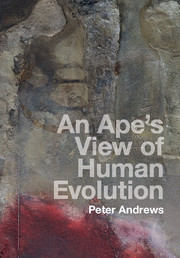Book contents
- Frontmatter
- Contents
- Preface
- 1 How can we recognize common ancestors?
- Part I Apes: their morphology and behaviour
- PART II Environments and palaeoenvironments
- 5 Structure and composition of ape environments
- 6 Environmental indicators
- Part III Review of fossil apes
- Part IV Last common ancestor
- References and further reading
- Index
- References
5 - Structure and composition of ape environments
from PART II - Environments and palaeoenvironments
Published online by Cambridge University Press: 05 January 2016
- Frontmatter
- Contents
- Preface
- 1 How can we recognize common ancestors?
- Part I Apes: their morphology and behaviour
- PART II Environments and palaeoenvironments
- 5 Structure and composition of ape environments
- 6 Environmental indicators
- Part III Review of fossil apes
- Part IV Last common ancestor
- References and further reading
- Index
- References
Summary
The species of living ape described in Chapters 2 and 3 have been well studied, both their behaviour and their ecology. Their inter‐relationship with their environment is key to understanding how they function, and in this chapter I am going to set out a simple classification of present-day environments in relation to the living apes, and this will then form the basis for interpreting past environments of fossil apes. It is my strongly held belief that our interpretations of the past can only be based upon what we can see around us today. This is not to say that environments in the past were identical to present-day environments, for many are demonstrably different, but they differ in ways that can be interpreted by our knowledge of present ecologies. Records of fossil plants, for example, show us when particular species of plants first appeared, and whether they were related to present-day forest or woodland species, but they do not tell us about the structure, the ecophysiology, of the environment. For this we need evidence from other sources that will be described in the next chapter.
Modern environments
In order to relate fossil and recent apes to their environment, it is necessary to provide a brief classification of the terms used here. There are numerous classifications of vegetation structure as applied to ape and human environments, and it seems that every work on palaeoecology adopts one or other of them, never the same. The one that Judy Van Couvering and I used in 1975 was modified from Peter Greenways's 1943 vegetation classification of East African vegetation, and it is the one I have used ever since. Thure Cerling has recently proposed one that combines his carbon isotope (δ13C) work with the classification by Frank White of African vegetation for the UNESCO vegetation map of Africa. This is the seminal work on African vegetation, and I have combined it with my earlier scheme to produce the following classification. It will be restricted to just four biomes (major regional ecological communities of plants and animals), which have similar types of vegetation as a result of similar climate regimes. This is often as far as palaeoecological interpretation can go, but where evidence is good it may be possible to recognize different types of plant formation within these biomes.
- Type
- Chapter
- Information
- An Ape's View of Human Evolution , pp. 69 - 81Publisher: Cambridge University PressPrint publication year: 2016



